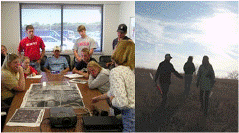Environmental and Sustainability Studies Program

Department of Environmental Studies: Undergraduate Student Theses
Date of this Version
5-2022
Document Type
Thesis
Citation
Environmental Studies Undergraduate Student Thesis, University of Nebraska-Lincoln, 2022
Abstract
Heat waves can lead to illness and death, particularly among older adults, the very young, and other vulnerable populations. More frequent severe heat waves are expected to impact Nebraska. Looking specifically into Lincoln, NE for future climate trends, over the next 100 years, “the number of hot days would increase by 13-22 days during a given summer (depending upon the scenario), and the number of warm nights would increase by 20-35 nights each summer” Bathke et al. (2014). These higher summer temperatures will “increase electricity use, causing higher summer peak loads” as well as “pose physical and mental health challenges…outdoor work will become more difficult, riskier, and less productive” Bathke et al. (2014). Prolonged exposure to excessive heat can lead to other impacts such as damaged crops, injured or dead livestock, and increased risk of wildfires. In order to mitigate some of these effects, adequate tracking and monitoring of apparent temperatures, increased relative humidity, and WBGT must occur. One solution for this is through utilization of online tools, apps, and 2 simple calculators in order to provide warning to vulnerable populations and help better prepare the general public. In this study, through the methods of meta-analysis, visual representation with charts and graphs, and comparative analysis, exploratory-based research was carried out on eight counties (Scotts Bluff, Cherry, Madison, Custer, Lancaster, Keith, Phelps, and Jefferson) with the respective climate divisions of 1, 2, 3, 5, 6, 7, 8, 9 as defined by the Climate Prediction Center (CPC). The cities from each county were: Scottsbluff, Valentine, Norfolk, Broken Bow, Lincoln, Ogallala, Holdredge, and Fairbury. For each location, apparent temperature was calculated in order to observe noticeable summer temperature trends under the last climate normal period (1991-2020). Five wet bulb globe temperature (WBGT) tools were also analyzed in terms of readability, ease of access, amount of information and data available, accuracy, and completeness in order to create and optimize one for the Nebraska area. Cooling Degree Day (CDD) trends were also looked at to determine whether or not increased relative humidity and apparent temperatures had an effect on them. It was determined that the most optimized tool would have advanced equations, sufficient background data, a five day extended outlook, and appropriate work/rest interval and water intake information. Sharp increases in AT were observed in 1995, 2006, 2012, and 2017 with each of these years corresponding to a major heat event: Chicago Heat Wave, North American Heat Wave, Heat Wave/Drought, and the Heat Dome/Record Breaking heat, respectively. These patterns matched the highest recorded CDD in the summer of 2012 at 1,344.4 CDD.
Included in
Environmental Education Commons, Natural Resources and Conservation Commons, Sustainability Commons


Comments
Copyright 2022, Rachel T. Hines